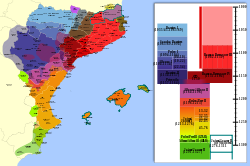
Back Condau de Barcelona AN كونتية برشلونة Arabic Графство Барселона Bulgarian Comtat de Barcelona Catalan Barcelonské hrabství Czech Grevskabet Barcelona Danish Grafschaft Barcelona German Κομητεία της Βαρκελώνης Greek Condado de Barcelona Spanish Barcelona krahvkond Estonian
County of Barcelona | |||||||||||
|---|---|---|---|---|---|---|---|---|---|---|---|
| 801–1162 | |||||||||||
 The county of Barcelona (red) in the context of peninsular expansion of the Crown of Aragon. | |||||||||||
| Status | County of the Frankish Empire (801–10th century) Independent county (10th century–1162) | ||||||||||
| Capital | Barcelona | ||||||||||
| Common languages | Occitano-Romance (Old Occitan and Old Catalan), Latin | ||||||||||
| Religion | Chalcedonian Christianity (Roman Catholic after Great Schism c. 1054) | ||||||||||
| Government | Feudal monarchy | ||||||||||
| Count | |||||||||||
• 801–820 | Berà | ||||||||||
• 1131–1162 | Ramon Berenguer IV | ||||||||||
| Legislature | Comital Court | ||||||||||
| Historical era | Middle Ages | ||||||||||
• Established | 801 | ||||||||||
• Disestablished | 1162 | ||||||||||
| |||||||||||
| Today part of | |||||||||||
| History of Catalonia |
|---|
 |
| Timeline |
The County of Barcelona (Latin: Comitatus Barcinonensis, Catalan: Comtat de Barcelona) was a polity in northeastern Iberian Peninsula, originally located in the southern frontier region of the Carolingian Empire. In the 10th century, the Counts of Barcelona progressively achieved independence from Frankish rule, becoming hereditary rulers in constant warfare with the Islamic Caliphate of Córdoba and its successor states. The counts, through marriage, alliances and treaties, acquired or vassalized the other Catalan counties and extended their influence over Occitania. In 1164, the County of Barcelona entered a personal union with the Kingdom of Aragon. Thenceforward, the history of the county is subsumed within that of the Crown of Aragon, but the city of Barcelona remained preeminent within it.
Within the Crown, the County of Barcelona and the other Catalan counties progressively merged into a polity known as the Principality of Catalonia, which assumed the institutional and territorial continuity of the County of Barcelona.